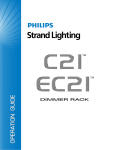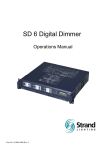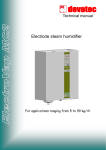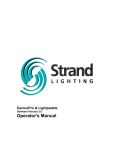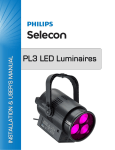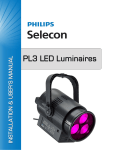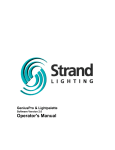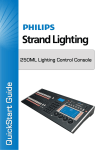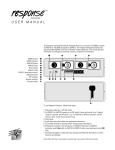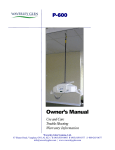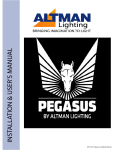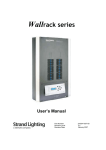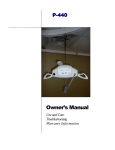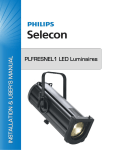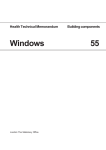Download CD80 Digital Pack
Transcript
CD80 Digital Pack
Instruction Sheet Part #:
Revision Level:
2-450161-010
F0
Written By:
Revised By:
Revision Date:
Don Lammers
Charles Coley
08/03/06
The material in this manual is for information purposes only and is subject
to change without notice. Strand Lighting assumes no responsibility for
any errors or omissions which may appear in this manual. For comments
and suggestions regarding corrections and/or updates to this manual,
please contact your nearest Strand Lighting office.
El contenido de este manual es solamente para información y está sujeto a
cambios sin previo aviso. Strand Lighting no asume responsabilidad por
errores o omisiones que puedan aparecer. Cualquier comentario,
sugerencia o corrección con respecto a este manual, favor de dirijirlo a la
oficina de Strand Lighting más cercana.
Der Inhalt dieses Handbuches ist nur für Informationszwecke gedacht,
Aenderungen sind vorbehalten. Strand Lighting uebernimmt keine
Verantwortung für Fehler oder Irrtuemer, die in diesem Handbuch
auftreten. Für Bemerkungen und Verbesserungsvorschlaege oder
Vorschlaege in Bezug auf Korrekturen und/oder Aktualisierungen in
diesem Handbuch, moechten wir Sie bitten, Kontakt mit der naechsten
Strand Lighting-Niederlassung aufzunehmen.
Le matériel décrit dans ce manuel est pour information seulement et est
sujet à changements sans préavis. La compagnie Strand Lighting n'assume
aucune responsibilité sur toute erreur ou ommission inscrite dans ce
manuel. Pour tous commentaires ou suggestions concernant des
corrections et/ou les mises à jour de ce manuel, veuillez s'll vous plait
contacter le bureau de Strand Lighting le plus proche.
Copyright 1992, 2006, Strand Lighting. All rights reserved.
Information contained in this document may not be duplicated in full or in part by any person without prior
written approval of Strand Lighting. Its sole purpose is to provide the user with detailed operational
information for the equipment supplied. The use of this document for all other purposes is specifically
prohibited.
Strand Lighing North America Office:
6603 Darin Way, Cypress, CA 90630
Tel: 1-714-230-8200
Fax: 1-714-899-004215
Table of Contents
Introduction and Assistance ............................................... 1
Manual Organization .........................................................................1
Definitions .........................................................................................2
Conventions.......................................................................................3
Technical Assistance .........................................................................3
Problems.......................................................................................3
Technical Questions .....................................................................3
Parts Purchases .............................................................................3
Comments and Suggestions..........................................................3
Addresses .....................................................................................3
Operational Features ........................................................... 5
Protocol..............................................................................................5
Configuration.....................................................................................5
Analog Input......................................................................................6
Dimming Characteristics ...................................................................6
Regulation ....................................................................................6
Output...........................................................................................6
Efficiency .....................................................................................6
Protection...........................................................................................7
Dimmer Level Retention ...................................................................7
Servicing............................................................................................7
Hardware Description .......................................................... 9
Chassis.............................................................................................10
Digital Controller.............................................................................11
Control Module Front Panel.......................................................11
Controller Electronics.................................................................12
Power Control and Cooling Assemblies..........................................12
Dimmer Types .................................................................................13
UL And CSA Approval..............................................................13
Input Power Connectors ..................................................................14
Installation .......................................................................... 15
Preparation.......................................................................................15
Environmental Considerations ...................................................15
Power Requirements...................................................................15
Three Phase Power Requirements.........................................15
Single Phase Power Requirements........................................15
Plan Pack Positioning.................................................................16
Plan Wiring Layout ....................................................................17
Table of Contents
i
Installation .......................................................................................18
Install Packs................................................................................18
Set Correct Phasing ....................................................................19
Set for Single Phase Operation .............................................19
Set for Three Phase Operation (default)................................19
Connect Power ...........................................................................20
Connect Load Wires...................................................................21
Connect Control Wires...............................................................22
AMX192 Control Wiring......................................................22
DMX512 Dimmer Control Wiring........................................23
Setup ................................................................................................24
Dimmer Signal Number .............................................................24
Combining Pack Types ..............................................................24
Dimmer Number Offset..............................................................25
Set 6Kw/12Kw Control Mode....................................................26
Use Every Control Signal (default).......................................26
Use Every Other Control Signal ...........................................26
Set Dimmer Curve......................................................................27
Modified Square Law Curve (default) ..................................27
Analog Pack Matching Curve ...............................................27
Using AMX192 Dimmer Control...............................................28
Using DMX512 Dimmer Control...............................................29
Discreet Analog Control Hookup ....................................................30
Set Analog Pile-on Mode ...........................................................31
Analog Plus Protocol ............................................................31
Highest Takes Precedence (default)......................................31
Set Analog Input Level ..............................................................31
Zero to +10VDC (default).....................................................31
Zero to +15VDC ...................................................................31
Set "Status Quo" ..............................................................................32
"Status Quo" OFF (default)...................................................32
"Status Quo" ON ...................................................................32
Fault Protection ...............................................................................32
Hot Pocket .......................................................................................33
Local Dimmer Control.....................................................................33
Dimmer Panic.............................................................................33
ON/NORMAL Push-buttons......................................................33
Mode Switch Settings......................................................................34
Retrofitting an Analog Pack ............................................................34
Index
ii
Basic Trouble-shooting ..................................................... 35
Component Removal .......................................................................35
Controller Replacement..............................................................35
Removing the Controller.......................................................36
Installing the Controller ........................................................36
SSR Replacement .......................................................................36
Replacing a 1.2Kw or 2.4Kw Dual SSR ...............................36
Replacing a 2.4Kw or 6Kw Single SSR................................36
Replacing a 12Kw Single SSR..............................................37
Changing other components..................................................37
Problems Affecting the Entire Pack ...........................................37
Problems Confined to a Single Phase.........................................38
Individual Dimmer Problems .....................................................39
Periodic Maintenance......................................................... 41
Index .................................................................................... 47
Table of Figures
Figure 1. CD80 Digital Pack……………………….…………….9
Figure 2. CD80 Digital Pack Controller………………..……….11
Figure 3. CD80 Pack Wall Mounting………………..…….……17
Figure 4. 1.2Kw Pack Power Connection…………………..…...20
Figure 5. 2.4Kw & 6Kw Pack Power Connection………..……..20
Figure 6. 12Kw Pack Power Connection…………..……………21
Figure 7. XLR to TA4 Series……………………………..……..22
Figure 8. AMX192 Extension…………………………………...23
Figure 9. DMX512 Dimmer Control Cable………...…….……..23
Figure 10. Dimmer Curve Jumper Location…………………….27
Figure 11. Connect Packs for AMX192……..………………….28
Figure 12. Connect Packs for DMX512………………………...29
Figure 13. Digital Dimmer Controller Remova…………………35
Figure 14. 1.2 Kw Digital Pack Parts…………………………...42
Figure 15. 2.4Kw Digital Pack Parts…..………….…………….15
Figure 16. 6Kw Digital Pack Parts……….……………………..44
Figure 17. 12Kw Digital Pack Parts…………………………….45
Table of Tables
AMX192 Control Inputs..................................................................22
DMX512 Control Inputs..................................................................23
Discreet Analog Input Connections.................................................30
Mode Switch Settings......................................................................34
Table of Contents
iii
Index
iv
Chapter
1
Introduction and Assistance
This manual provides information on the operating procedures for the
CD80 Digital Dimmer Pack.
Manual Organization
This manual contains the chapters shown below, plus an Index.
Introduction and Assistance (chapter 1) - tells you about the organization
of this manual, plus definitions and conventions used. Also tells you
how to get technical help if necessary
Operational Features (chapter 2) - gives an overview of the operational
features of CD80 Digital Packs.
Hardware Description (chapter 3) - gives an overview of the hardware
and how it works together.
Installation (chapter 4) - tells you about the installation requirements for
CD80 Digital Packs and peripherals. This chapter shows pinouts for
externally accessible connectors, cable types and lengths, and (where
applicable) setup information.
Basic Trouble-shooting (chapter 5) - tells you how to begin troubleshooting if you have problems with a pack. Since actual internal
repair of the pack electronics is beyond the scope of this manual, this
chapter shows only the basic steps you can take without having to
replace individual circuit parts, and before you call for help from
Strand Lighting.
Periodic Maintenance (chapter 6) - lists the steps which should be taken
to keep your Digital Packs running at their best.
Introduction and Assistance
1
Definitions
This manual uses the following definitions throughout:
Circuit Connection device and wiring for powering a lighting fixture from a
dimmer.
Dimmer Device controlling power to a lighting fixture. Two lights on the same
dimmer cannot be separately controlled.
Channel Device controlling a dimmer or group of dimmers. Historically, there is a
physical controller (such as a slider) for each channel. On most current
control systems, channels are numbers accessed by a numeric keypad.
Each channel can control multiple dimmers.
Patch Historically, the process of physically connecting circuits to dimmers.
Now usually refers to electronic assignment of dimmers to channels.
"Patch" does not refer to assignment of channels to cues or submasters.
Preset A pre-defined setup of intensities for a set of channels, stored in memory
for later replay.
Memory Storage location for preset information.
Cue The process of recalling a preset from its memory location and putting the
result on stage.
Preset, Memory, and Cue are often used interchangeably.
Submaster A controller (usually a linear slider controller) which allows manual
control of groups, effects, cues, or channels.
Fade A gradual change in stage levels from one set of intensities ("look") to
another.
Up-fade The portion of a fade which involves only channels which are increasing
in level.
Down-fade The portion of a fade which involves only channels which are decreasing
in level.
Crossfade A fade which contains both an up-fade and a down-fade. Also may refer to
any fade where the levels of one cue are replaced by the levels of another
cue.
Bump An instantaneous change in stage levels from one set of intensities ("look")
to another.
Introduction and Assistance
2
Conventions
The following conventions are used in this manual:
ON (all capital text) shows to the status of a function or switch, as in "Turn the switch
ON."
Live (text with first letter capitalized) shows the name of a function or mode of
operation, as in Live mode, Group function, or Preview display.
Technical
Assistance
CD80 Digital Dimmer Packs require a minimum of maintenance and
servicing.
Problems If equipment fails to operate properly upon installation, or under normal
load and temperature conditions, and basic trouble-shooting procedures are
not effective, please contact Strand Lighting Field Service or an
Authorized Service Center serving your area. Strand Lighting will issue a
Return Goods Authorization before the return of any defective materials.
This allows tracking of returned equipment, and speeds its return to you.
Technical Questions For technical questions regarding setup, operation, or maintenance of this
equipment, please contact the Strand Lighting Field Service or an
Authorized Service Center serving your area.
Parts Purchases For purchase of spare parts or documentation, please contact Strand
Lighting Customer Service or an Authorized Service Center serving your
area.
Comments and For comments regarding equipment functions and/or possible
Suggestions improvements, or for comments on this manual, please call or write to the
Customer Service Manager at the Strand Lighting office serving your area.
Addresses Contact information for all the Strand Lighting offices are shown on the
reverse side of the manual title sheet and on our web-site:
www.strandlighting.com or call 1 (800) 4-STRAND (1-800-478-7263).
Contact information for all local Authorized Service Centers are located on
our web-site: www.strandlighting.com
Introduction and Assistance
3
Introduction and Assistance
4
Chapter
2
Operational Features
This chapter presents the basic operational features of the CD80 Digital
Pack.
Protocol
The CD80 Digital Pack Controller will accept and decode AMX192
multiplexed analog signals or DMX512 digital dimmer protocols.
Caution
Configuration
Protocol type is sensed automatically by the Controller
Separate analog and digital protocol input connectors allow you to hook
analog and digital control to each pack simultaneously if required.
If the controller senses more than one protocol hooked up and active it
will lock onto the first protocol it sees, and stick with that protocol until
the protocol disappears. When a Digital Pack Controller is first powered
up it will scan the AMX192 port first, and then the digital port. If signals
are present on both, the AMX192 signal will take priority.
One CD80 Digital Pack contains 24 1.2Kw dimmers, 24 2.4Kw dimmers,
twelve 2.4Kw dimmers, or six 6Kw or 12Kw dimmers.
The controller can be set to start "reading" dimmer levels at any dimmer
number required (1-192 for AMX192 and 1-512 for DMX512 signals). This
provides maximum flexibility in using CD80 Digital Dimmer Packs with
multiple consoles and/or other types of packs or dimmers.
The 12 channel controller can be set to read 12 consecutive control signals
and control either 12 or 6 consecutive dimmers, or to read every other signal
of 12 to control 6 consecutive dimmers. The second option is used for
systems where the 6Kw/12Kw assignments will be handled by the console
patch.
Operational Features
5
Analog Input
The CD80 Digital Pack Controller can input 12 (Cat. #76471) (old #8216)
or 24 (Cat. #76470) (old #8215) discreet analog signals in addition to the
signal from the main console. This is an easy way to set up manual house
lights, or set up a minimum dimmer level for some of the dimmers.
The controller can read 0-10VDC or 0-15VDC analog signals.
Analog input processing can be set for standard pile-on operation or so that
the dimmer level is the discreet analog input level plus the protocol input
level (up to a maximum of 100%).
12 (Cat. #76471) (old #8216) or 24 (Cat. #76470) (old #8215)
ON/NORMAL (override) push-button switches let you turn any dimmer ON
without a console or discreet analog signal, or override the console and
discreet analog inputs.
Dimming
Characteristics
Regulation Each 120VAC dimmer module, with circuitry in the Digital Controller
module, regulates output voltage with changes in the AC line from 108 to
130 volts RMS.
Dimmers will maintain output RMS voltage within ±2% with changes in
load from 10 watts to full rated load at any point on the dimming curve (30
watts to full rated load for 12Kw Packs).
Output
Output RMS voltage versus setting follows a modified square law dimming
curve.
Output waveform is a variable conduction angle 120VAC sine wave.
Output waveform risetime is greater than 500 microseconds.
Output response time (from control signal change) is less than 0.1 seconds.
Output connections can be Grounded Twist Lock, Pin Plug, U-Ground
(2.4Kw Packs only), or terminal strip outputs.
Efficiency The power efficiency of the dimmer is a minimum of 95% at full load.
Operational Features
6
Protection
Front panel overtemperature indication. The OverTemp thermostat will turn
OFF all dimmers in the pack when the temperature on the pack heat sink is
greater than 85°C.
Solid State Relay Peak Surge Rating:
• 2.4Kw Pack - 600 Amps.
• 6Kw Pack - 1000 Amps.
• 12Kw Pack - 1000 Amps.
Short Circuit Protection:
• 2.4Kw - Fully Magnetic breakers protect against shorts across 40 feet
of #14 AWG cable. Short circuit proof version withstands shorts at
output plug (lifetime 100 surges).
• 6Kw Pack - Fully magnetic breakers protect against shorts across 125
feet of #8 AWG cable (lifetime 100 surges).
• 12Kw Pack - Fully magnetic breakers protect against shorts across 125
feet of #8 AWG cable (lifetime 100 surges).
Dimmer Level
Retention
The microprocessor will maintain current dimmer levels ("Status Quo"
memory) for 30 minutes if there is a loss of control signal (i.e., when you
turn the console OFF). This feature can be turned OFF if required.
Servicing
The CD80 Digital Pack is designed to be easily serviced in the field. It
incorporates:
Rapidly replaceable Controller module.
Rapidly replaceable SSR modules.
Operational Features
7
Operational Features
8
Chapter
3
Hardware Description
The CD80 Pack is a lightweight portable performance dimming pack
containing twelve and twenty-four (2.4Kw pack) or six (6Kw or 12Kw
Pack) dimmers.
Size - 23.25" x 20.00" x 7.75"
Weight - 65 pounds
125" aluminum alloy housing.
Grey semi-gloss power coat finish with off-white silkscreened graphics.
Integral carrying handles for transporting.
Optional wall mounting.
Figure 1. CD80 Digital Pack
Hardware Description
9
Chassis
The CD80 Pack chassis consists of a main structural chassis (bottom
housing and front panel), a removable top, and an interchangeable rear
connector panel. The heavy gauge structural panels create a rugged
container even though assembled with only four pieces.
The main structural chassis consists of the bottom housing and front panel
fastened rigidly together. The front panel is recessed to protect the
breakers and PCB face panel components.
The front panel, constructed of .090 thick aluminum alloy, contains U.L.
listed circuit breakers and a slot for the plug-in printed circuit board
module.
The bottom housing, constructed of .125 thick aluminum alloy, supports a
heat sink subassembly (mounting the solid state relays and an overheat
thermostat), a fan, a fan guard, a torroidal choke subassembly (with chokes
solidly mounted in a "clamshell" Lexan retaining channel), and a power-in
knock-out, provided for customer removal for terminal wiring. The rear
panel is attached to the main structural chassis and recessed to protect the
connector faces. Four large diameter feet, approximately 3/4" high, are attached to the underside of the bottom housing and existing feet mount
holes are accessible for easy wall mounting.
The rear connector panel, constructed of .090 thick aluminum alloy, is
manufactured in four customer options:
Pin connectors
Twist lock GTL connectors (2.4 and 6Kw units only).
Straight blade (Duplex) connectors (on 2.4Kw only)
A terminal block for hard wiring of outputs plus control.
The top cover, constructed of .125 aluminum alloy, fastens to the main
chassis by four screws, and allows easy access for servicing. Recessed
handles are integrated into the top housing for easy one man carry
capability. Instruction labels are affixed to the underside of the top cover
and a warning label..., "Disconnect power before removing top"...attached
to the top of the cover.
Hardware Description
10
Digital Controller
The plug-in controller, accessible on the front panel of the CD80 Pack, is
made of a face plate and control card. The Control Module contains all
necessary indicators and control electronics, allowing rapid interchange of
active components in the field without the need for calibration or
adjustment.
Figure 2. CD80 Digital Pack Controller
Control Module The following functions and indicators are on the Control Module face
Front Panel plate:
Three Power Indicators (green) - show when each power phase is present.
Three Protocol Indicators (yellow) - show which input protocol is currently
being decoded.
A 6 position Mode Select DIP switch for selecting various parameters.
OverTemp Indicator (red) - On when heat sink temperatures exceed +85°C.
The pack will shut down when this function is activated.
Input and output connectors for analog (AMX192) and digital (DMX512)
multiplexed inputs.
Input connector(s) for up to 12 or 24 discreet analog control signals.
A set of three thumbwheel switches for selecting the start dimmer number
for the pack.
An alternate action "Panic" switch - to turn all dimmers ON full. Push this
switch again to return all dimmers to normal operation.
A "Reset" switch - to restart the processor if required.
12 or 24 alternate action ON/NORMAL (override) push-button switches let
you turn any dimmer ON without a console or discreet analog signal, or
override the console and discreet analog inputs. These switches are backlit to
show the approximate level of the associated dimmer.
Hardware Description
11
Controller Electronics The CD80 Digital Pack Controller will accept and decode AMX192
multiplexed analog signals or DMX512 digital dimmer protocols. An
additional connector (2 connectors on 24 channel units) allows inputting
discreet analog signals if requires.
The Controller electronics contains all of the electronics required to detect
input signal type, decode the incoming signal, and produce 24 phase
synchronized pulse width modulated control signals to drive the SSRs.
The electronics are powered from a power supply connected to the phase
A power source. The phase B and phase C power sources are used for
phase reference only.
Power Control and
Cooling Assemblies
The following circuit and thermal elements in the bottom housing and
front panel serve to control and dissipate power in the CD80 Pack:
One SSR for each dimmer, rated appropriately for the dimmer power rating,
are mounted on a common 18" long heat sink anchored to the bottom
housing. Each SSR is field replaceable.
One torroidal choke for each dimmer is mounted in a common assembly
adjacent to the heat sink.
One primary, fully magnetic circuit breaker for each dimmer is mounted to
the front panel and provides for protection of individual dimmers.
A fan mounted on the positive pressure side of the heat sink provides approximately 70 CFM (derated) of cooling air through the enclosure.
A phase changing/terminal block assembly on the bottom housing (except
12Kw packs) provides termination of either 3 phase 4-wire plus ground
120/208VAC 80 AMPS, or single phase 3-wire plug ground 120/240VAC
120 AMPS.
Hardware Description
12
Dimmer Types
Dimmer modules are available in the following 120VAC configurations.
These dimmers are intended for use with incandescent and inductive loads
only.
UL And CSA Approval The following CD80 Digital Packs are UL listed and CSA approved:
8324 - 24 1.2Kw dimmers (15A primary breaker) with 24 20A Twist Lock
outputs.
8325 - 24 1.2Kw dimmers (15A primary breaker) with 24 20A Pin
Connector outputs.
8326 - 24 1.2Kw dimmers (15A primary breaker) with 24 20A U-Ground
outputs.
8327 - 24 1.2Kw dimmers (15A primary breaker) with terminal strip
connections.
8328 - 24 1.2Kw dimmers (15A primary breaker) with 24 15A U-Ground
outputs.
73205 – Twelve 2.4Kw dimmers (20A primary breaker) with 12 20A Pin
Connector & two 6-circuit socapex outputs.
73206 – Twelve 2.4Kw dimmers (20A primary breaker) with 24 20A Twist
Lock Connector & two 6-circuit socapex outputs.
73210 (old #8524) - Twelve 2.4Kw dimmers (20A primary breaker) with 24
20A Twist Lock outputs.
73211 (old #8525) - Twelve 2.4Kw dimmers (20A primary breakers) with
24 20A Pin Connector outputs.
73214 (old #8527) - Twelve 2.4Kw dimmers (20A primary breakers) with
terminal strip outputs (intended for wall mounting).
73240 – Twenty-Four 2.4Kw dimmers (20A primary breakers) with Twist
Lock outputs.
73241 - Twenty-Four 2.4Kw dimmers (20A primary breakers) with Pin
Connector outputs.
73244-GR - Twenty-Four 2.4Kw dimmers (20A primary breakers) with U
Ground outputs.
73244 - Twenty-Four 2.4Kw dimmers (20A primary breakers) with Output
Terminals.
73247 - Twenty-Four 2.4Kw dimmers (20A primary breakers) with Four 6circuit Socapex receptacles.
73220 (old #8566) - Six 6Kw dimmers (50A primary breakers) with 12
Twist Lock outputs.
73221 (old #8567) - Six 6Kw dimmers (50A primary breakers) with 12 Pin
Connector outputs.
73224 (old #8568) - Six 6Kw dimmers (50A primary breakers) with terminal
strip outputs (intended for wall mounting).
73227 – Six 6Kw dimmers (50A primary breakers) with 6 Pin Connector
outputs
73230 – Six 12Kw dimmers (100A primary breakers) with 6 Pin Connector
outputs.
73234 (old #8564) - Six 12Kw dimmers (100A primary breakers) with
terminal strip outputs (intended for wall mounting).
Hardware Description
13
The following CD80 Packs are UL listed but not CSA approved:
Caution
73212 (old #8526) - Twelve 2.4Kw dimmers (20A primary breakers) with
24 20A U-Ground outputs.
These dimmer packs are designed and rated for use with incandescent or
inductive loads only. Dimmer packs may be damaged if used with any
other type of loads.
The following controllers are available for retrofitting and spares:
76470 (old #8215) - 24 channel Digital Pack Controller (for 1.2Kw packs)
76471 (old #8216) - 12 channel Digital Pack Controller and retrofit kit (for
2.4Kw, 6Kw, and 12Kw packs).
The 24 channel Digital Pack Controller cannot be retrofitted into any
existing CD80 packs. Cat. #76470 contains only a 24 channel Digital
Pack Controller. The 12 channel Digital Pack Controller is a direct
replacement for the Multiplexed Analog Pack Controller (part #3258358-010) and the Discreet Analog Pack Controller (part #3-258362010). Cat. #76471 contains a 12 channel Digital Pack Controller and the
necessary items for retrofitting older CD80 packs.
Input Power
Connectors
A variety of input power connectors can be custom mounted in the CD80
pack if required. Packs using special input connectors may not carry CSA
approval or UL listing. Please contact your sales representative for details.
Hardware Description
14
Chapter
4
Installation
Preparation
Before installing your CD80 Packs, you should carefully consider the
environment in which the equipment is to be installed, the power feeding
the equipment, and the required conduit and/or cable runs.
Environmental To maximize equipment life, and minimize the chance of failures, the
Considerations following environmental requirements should be met:
Caution
Temperature -- 40°C (104°F).
Humidity -- 5%-80% relative humidity maximum, no condensation.
Dimmer pack efficiency is at least 95%. Since the remainder of the
energy is dissipated as heat, they should be installed in a room with
adequate ventilation to dissipate a heat load equivalent to 5% of the
maximum load the dimmer racks will handle.
Power Requirements 2.4Kw and 6Kw CD80 Digital Dimmer Packs can be powered by three
phase or single phase power. 12Kw Digital Dimmer packs must be
powered by three phase power.
Three Phase Power Requirements
12 circuit 1.2Kw or12 circuit 2.4Kw Pack - 120/208VAC, 80 Amps, 4-wire
plus ground.
24 circuit 2.4Kw Pack - 120/208VAC, 160 Amps, 4-wire plus ground
6Kw Pack - 120/208VAC, 100 Amps 4-wire plus ground
12Kw Pack - 120/208VAC, 200 Amps, 4-wire plus ground
Single Phase Power Requirements
Warning
1.2Kw or 2.4Kw Pack - 120VAC, 120 Amps, 3-wire plus ground
6Kw Pack - 120VAC, 150 Amps 3-wire plus ground
12Kw Pack - Single phase operation is not allowed
Do not install this equipment with power applied. Make sure that your
incoming power is disconnected before proceeding.
Do not provide 220VAC power to a 120VAC pack, as damage may
result.
Installation
15
Plan Pack Positioning CD80 Packs may be placed on any flat surface for normal operation. You
may stack up to 8 units vertically. Do not place more than 2 units side to
side unless there is at least 24 inches between packs. Otherwise, the hot air
exhaust from each unit will simply feed into the next. In permanent or
semi-permanent installations, you can build shelves to hold packs or
mount them on a wall separated by at least 24 inches horizontally. Vertical
shelf spacing should allow removal of the CD80 Pack top covers for
access to SSR modules if required. Figure 3 shows dimensions and
existing mounting holes.
Warning
This equipment is intended for indoor use only.
Utilizer dans endroit a L'abri.
For CSA approval when mounting over a combustible surface, a floor
plate of at least 1.44mm galvanized or 1.6mm uncoated steel extended
at least 150mm beyond the equipment on all sides must be installed.
Lorsque L'appareil est installe sur ou au-dessus d'une surface
combustible, on doit prevoir une plaque d'acier galvanise d'au moins
1.44mm ou une plaque d'acier sans revetement de 1.6mm se prolongeant
sur au moins 150mm tout autour de l'appareil.
Plan Wiring Layout
Figure 3. CD80 Pack Wall Mounting
Installation
16
When installing packs with terminal strip wiring, the location of conduit
runs and their entrance to the pack is important and should be carefully
planned before cutting holes or attaching conduit. Figure 3 shows the
allowed entry areas for the various types of wiring. When installing
portable packs, all connections are external.
When you are planning a hookup for a portable system you should avoid
running control and load wires parallel to each other. The radio frequency
noise produced by the load wiring may cause disruption to the control
signal.
Caution
Do not run power feed or load wires in the same conduit or wireway as
control wiring.
Do not run wiring from other unrelated equipment in the same conduit
with CD80 wiring.
Do not run wiring in ways other than shown on system riser diagram.
CD80 systems are designed to be installed in a specific manner.
Do not substitute plastic conduit for metal where conduit is called for.
Metal conduit acts as a ground and shield.
Do not substitute shielded wiring for unshielded wiring or conduit.
Changes in transmission line capacitance can cause problems with the
control signals.
Installation
Once you have determined that all required conditions for the installation
will be met, you can install the packs.
Installation
17
Install Packs Install the dimmer packs and run conduit as required.
1. Unpack the packs.
2. Make sure that any conduit work which will be covered up is completed.
3. Set or fasten packs in place as planned. If you are mounting packs on the
wall, make sure that the fan is at the bottom of the unit as mounted.
5. Cut required conduit holes and install conduit.
6. Vacuum out any metal chips resulting from making conduit holes.
Installation
18
Set Correct Phasing Mode Switch 2 sets the type of power the Control Module will be
expecting. You must set this switch and the phase selector plug inside the
pack to the same phase type. The factory default setting for Mode Switch 2
and the phase selector plug is 3-phase.
The phase changing terminal assembly (consisting of a terminal block and
a connector pair assembly) provides termination for a 3-phase 4-wire
240/208VAC 80 AMP power source or a single phase 3-wire
120/240VAC 120 AMP power source in 2.4Kw and 6Kw CD80 Packs.
Set for Single Phase Operation
1. Make sure power to the pack is OFF and
take the top cover OFF.
2. Plug the phase connector into the single
phase side of the phase receptacle.
3. Set Mode Switch 2 to ON.
4. Replace the top cover unless you still
need to connect power.
Set for Three Phase Operation
(default)
1. Make sure power to the pack is OFF and
take the top cover OFF.
2. Plug the phase connector into the three
phase side of the phase receptacle.
3. Set Mode Switch 2 to OFF.
4. Replace the top cover unless you still
need to connect power.
12Kw Packs are always operated with three phase power. Make sure
that the Mode Switch 2 is set to OFF for any 12Kw packs. There is no
phase change plug inside a 12Kw Pack.
Installation
19
Connect Power Connect power to the pack by attaching your power leads to the power
terminal block inside the pack. For portable packs, close the pack up after
connecting power. For terminal strip packs, leave the top open to connect
load wires.
The only components that do not come installed in the pack are the
neutral bus bar set screws. They are in a plastic bag attached to the
neutral bus bar.
Figure 4. 1.2Kw Pack Power Connection
Figure 5. 2.4Kw & 6Kw Pack Power Connection
Installation
20
Figure 6. 12Kw Pack Power Connection
Connect Load Wires Connect the load wires by plugging them into the rear panel connectors
(portable units) or connecting them to the internal terminal blocks
(terminal block packs). On 12Kw packs the load wires are connected
directly to the solid state relays.
Caution
These dimmer packs are designed and rated for use with incandescent or
inductive loads only. Dimmer packs may be damaged if used with any
other type of loads
Installation
21
Connect Control Wires CD80 Digital Dimmer Packs accept control signals conforming to the
USITT AMX192 or DMX512 Dimmer Signal Specifications.
AMX192 Control Wiring
The three types of connections provided in Strand Lighting equipment for
the AMX192 signal are the XLR style connector, the TA4/TY4 Series
Mini-SwitchCraft connector, and terminal blocks. Unless otherwise
specified, dimmer cabinets use terminal block connections and consoles
use XLR style connectors (see table 1 for pin assignments).
Table 1. AMX192 Control Inputs
Cable:
Belden 9156 or equal. May use Belden 8723 for adapters under
100 feet (30m) long.
Max Length: 1000 feet (300m). must be Daisy chained - no branching runs.
Connector:
Terminal block in fixed cabinets and racks. "XLR" style
connector, or SwitchCraft TA4/TY4 series connector on
moveable racks and packs, and on control consoles.
XLR TA4/TY4 Terminal
Belden Belden
Pin # Pin #
Pin #
Signal
Comments
8723
9156
4
2
1
3
1
3
2
4
AMX CLKAMX CLK+
AMX COM
AMX AMUX
CLOCK CLOCK +
COMMON
ANALOG
Clock Complement
Clock True
Analog Common
Multiplexed Analog
Green
White
Black
Red
Black
White
Black
Red
CLOCK+ and CLOCK- are one twisted pair. Analog and Common are
one twisted pair.
There are two AMX192 inputs, labelled "A" and "B." Use only "A"
terminals in systems with 192 AMX192 dimmers or less. Use both "A"
and "B" terminals for AMX192 systems with more than 192 dimmers.
Interconnection between equipment with different plug types requires an
adapter cable in which the plugs are not connected pin to pin (see figure
3).
Figure 7. XLR to TA4 Series Adapter
AMX192 adapters (under 100 ft) using TA4/TY4 connectors are made
with Belden #8723 cable (2 pairs of shielded 24 AWG wire). All other
runs are made with Belden #9156 (2 pairs of unshielded 18 gauge wire).
Installation
22
Figure 8. AMX192 Extension Cable
DMX512 Dimmer Control Wiring
The two types of connections provided in Strand Lighting equipment for
DMX512 dimmer control signals are the XLR style connector and terminal
blocks. Unless otherwise specified, dimmer cabinets use terminal block
connections and consoles use XLR style connectors (see table 2).
Table 2. DMX512 Control Inputs
Cable:
Max Length:
Belden 9829 or equal.
Standard RS485 electrical characteristics apply, including line
driver and receiver characteristics, line loading, and multi-drop
configurations.
Connector:
Terminal block in fixed cabinets and racks. "XLR" style
connector on moveable racks and packs, and on control consoles.
XLR Terminal
DMX
Wire
Pin #
Label
Signal Comments
Pairs Color
1
2
3
4
5
D-GND
DATADATA+
Not used
Not used
COMMON
DATA 1DATA 1+
DATA 2DATA 2+
Dimmer Common (shield)
Dimmer Drive Complement
Dimmer Drive True
Optional #2 Data Link Complement
Optional #2 Data Link True
shield
pair 1 wht/blue
blue/wht
pair 2 wht/org
org/wht
DATA 1- and DATA 1+ are one twisted pair. Common is tied to the
cable shield.
Figure 9. DMX512 Dimmer Control Extension Cable
Installation
23
Setup
Once you have installed the packs they must be set up to correctly read the
control signal from the console.
Dimmer Signal Number The first dimmer signal to which a Digital Pack Controller will respond is
set by the thumbwheel switches. When you are using AMX192 control
signals and 6Kw dimmers, the Mode Switch 6 on the front panel of the
controller can also effect the numbering.
Set the starting dimmer signal number for each pack by setting the
thumbwheel switches on the front of the control module to the appropriate
dimmer number. The CD80 Digital Pack Controller will start looking at
dimmer signals starting with the dimmer signal number set on the
thumbwheel switches.
Each pack is completely independent of all other packs. You can set two
packs to the same start number if you require more than one physical
dimmer for each dimmer number.
You do not have to set the start dimmer number to a boundary divisible
by 6 or 12. You can have a 2.4Kw pack set to dimmer 1 (the pack is
dimmers 1-12), with the next pack set to dimmer 9 (the pack is dimmers
9-20). This will give you two each of dimmers 9 through 12.
Combining Pack Types You may use combinations of 1.2Kw, 2.4Kw, 6Kw, and 12Kw packs in
the same installation. Make sure that you set the thumbwheel switches to
the correct dimmer numbers. Remember that a 6Kw or 12Kw dimmer pack
may use either 6 or 12 dimmer signals if you are using AMX192 control,
depending on the setting of Mode Switch 6. 1.2Kw packs use 24 dimmer
signals.
You can mix packs with analog multiplexed controllers, discreet analog
controllers, and old style 1.2Kw packs with CD80 Rack electronics if you
take a few precautions:
Disable the curve jumper on the digital packs used in the system so that
dimming curves match (see page 27).
Be careful about setting pack addressing for different pack types.
Remember that 6Kw analog multiplexed packs always use 12 dimmer
signals.
The input connector on 6Kw and 12Kw units as supplied by the factory uses
every other dimmer signal. If you wish them to be on consecutive channels
you must use the console to declare 6Kw/12Kw assignments or have
appropriately wired splitter boxes.
Installation
24
Dimmer Number Offset For purposes of pack dimmer numbering, each control cable from the
console is treated as a separate system. The first pack on the second
control cable must be set to "001" even though the actual console dimmer
number will be the number of dimmers on the first cable plus one.
In DMX512 systems dimmer #1 on control cable #2 is actually console
dimmer number 513, since the first cable controls 512 dimmers. For
DMX512 systems, this numbering is not affected by any 6Kw dimmers on
the first cable.
In AMX192 systems with only 2.4Kw dimmers, numbers on cable 2 are
offset by 96 or 192 (depending on the console) and each subsequent cable
is offset by an additional 192. This means that dimmer #1 (by the
thumbwheel switch) on cable #2 is actually console dimmer 97 or 193 in a
system with all 2.4Kw dimmers.
The following Strand Lighting control consoles output only 96 dimmer
signals from dimmer output #1, and 192 dimmer signals from all other
outputs. Each dimmer declared as 6Kw/12Kw in the control console patch
takes up two dimmer signals.
All versions of Mantrix
Mantrix Memory
miniPalette consoles set for 288 dimmer signals or less. When set for more
than 288 dimmer signals, these control consoles output 192 dimmer signals
from dimmer output #1.
Lightboard M consoles with AMX192 select jumper installed. Without this
jumper Lightboard M outputs 192 dimmer signals from dimmer output #1.
mini Lightpalette series consoles set for 288 dimmer signals or less. When
set for more than 288 dimmer signals, these control consoles output 192
dimmer signals from dimmer output #1.
Lightpalette, Lightpalette II, and Lightpalette III consoles with software
versions V6E and higher set for 288 dimmer signals or less. When set for
more than 288 dimmer signals these control consoles output 192 dimmer
signals from dimmer output #1.
Strand Lighting Light Palette Series consoles with software revisions V5A,
V5B, V6A and V6B output 96 dimmer signals from all control console
outputs when set for 384 dimmer signals or less. When set for more than
384 dimmer signals, these control consoles output 192 dimmer signals
from each output.
Very early Mantrix production consoles may not be compatible for
6Kw/12Kw Pack operation. If not, consult Strand Lighting.
Installation
25
Caution
When you are using AMX192 control signals, a 6Kw or 12Kw Pack uses
12 dimmer signals when Mode Switch 6 is OFF. This simulates the
analog multiplexed pack control module for easy retrofitting. You must
have 6Kw/12Kw dimmers declared in your control console patch for this
setup to work correctly. This also skews the dimmer offset for the next
control cable. For each 6Kw or 12Kw pack set up in this manner, the
dimmer offset is decreased by 6 dimmers, since 6 dimmer signals are
wasted per pack.
If Mode Switch 6 is ON, the 6Kw or 12Kw Pack only uses 6 dimmer
signals. You should not have 6Kw/12Kw dimmers declared in your
control console patch if you are using this setting. This method does not
skew the dimmer offset for the next cable, since all dimmer signals are
being used.
You can set some 6Kw or 12Kw packs for 6 signals and some for 12
signals as long as you adjust appropriately in your control console
patch. However, it is generally less confusing if all 6Kw/12Kw
addjustments are in patch or all are in the pack controllers. If you have
some Analog Multiplexed Pack Controllers and some Digital Pack
Controllers it is generally less confusing if you set all of the digital
controllers to mimic the analog controllers (Mode Switch 6 is OFF).
Set 6Kw/12Kw In order to maintain compatibility with older Strand Lighting equipment
Control Mode and procedures, you can set the CD80 Digital Pack Controller to use
consecutive incoming signals or use only every other signal. The factory
default setting for this switch is ON.
Use Every Control Signal (default)
To use every control signal for dimmer levels,
set Mode Switch 6 to ON. In this mode, the
controller will use the first 6 signals starting
from the thumbwheel dimmer number for 6Kw
packs, and the first 12 signals for 2.4Kw packs.
You should always use this setting for 2.4Kw Packs.
Use Every Other Control Signal
To use every other control signal for dimmer
levels, set Mode Switch 6 to OFF. This setting
is for Strand Lighting systems where the 6Kw
assignment is being made in the console. Since
2 consecutive signals are output for each 6Kw
dimmer assigned in the console, the CD80 Digital Pack Controller will use
every other signal starting with the thumbwheel dimmer number. This
setting is for retrofit situations where you already have 6Kw dimmers set
Installation
26
in the console and do not wish to reset the patch. You should not use this
setting in 2.4Kw Packs.
Set Dimmer Curve The CD80 Digital Pack Controller can be set so that its output curve
matches CD80 Multiplexed Analog and Discreet Analog Controllers, or
can be set with a modified square law curve which allows smoother
control at the lower end of the dimming curve. The setting is made with a
jumper. The factory default for this jumper is INSTALLED (modified
square law curve).
Figure 10. Dimmer Curve Jumper Location
Modified Square Law Curve (default)
1. Make sure power to the pack is OFF.
2. Remove the Digital Pack Controller from the pack
and locate jumper S44 (see figure 10 on page 27).
3. Install jumper S44 as shown.
4. Install the Digital Pack controller back in the pack.
5. Turn power to the pack back ON.
Analog Pack Matching Curve
1. Make sure power to the pack is OFF.
2. Remove the Digital Pack Controller from the pack
and locate jumper S44 (see figure 10 on page 27).
3. Move jumper S44 as shown so that it is inactive.
4. Install the Digital Pack controller back in the pack.
5. Turn power to the pack back ON.
Installation
27
Using AMX192 Figure 11 shows a typical system hookup using AMX192 control signals.
Dimmer Control Note that the 6Kw pack on output #1 (pack #3) is configured for skipping
every other control signal. This skews the numbering, so that dimmer 31
(pack #4) is actual controlled by control signal #37. The 6Kw pack on
output #2 (pack #10) is set to use every signal. This keeps the thumbwheel
numbering consistent with the actual dimmer signal used in each pack.
Figure 11. Connect Packs for AMX192
Installation
28
Using DMX512 Figure 12 shows a typical system hookup using DMX512 control signals.
Dimmer Control Since each DMX512 control cable transmits signals for 512 dimmers,
there will seldom be a need for more than one control cable in a typical
pack application. If you need a second cable, the first pack on the second
cable should be set to "001" just as it is with AMX192 systems.
Figure 12. Connect Packs for DMX512
Installation
29
Discreet Analog
Control Hookup
The CD80 Digital Pack Controller has a discreet analog input for each
control channel which can be piled on to the dimmer levels from the
selected incoming protocol. These signals are input through standard
DB15 connectors on the front of the controller. 24 channel controllers use
two DB15 connectors. Table 3 shows the pinouts of this connector.
These signals also appear at the rear of the pack on hard wired 1.2Kw
packs. They do not appear at the rear of 2.4Kw or 6Kw packs.
Table 3. Discreet Analog Input Connections
Connector:
Male DB15 connector (there are 2 connectors on 24 channel controller,
shown as pins 2-1 through 2-15 in this table)
Pin #
Signal Name
1-1
1-2
1-3
1-4
1-5
1-6
1-7
1-8
1-9
1-10
1-11
1-12
1-13
1-14
1-15
2-1
2-2
2-3
2-4
2-5
2-6
2-7
2-8
2-9
2-10
2-11
2-12
2-13
2-14
2-15
Analog 1
Analog 2
Analog 3
Analog 4
Analog 5
Analog 6
Analog 7
Analog 8
Analog 9
Analog 10
Analog 11
Analog 12
GND
GND
+12V
Analog 13
Analog 14
Analog 15
Analog 16
Analog 17
Analog 18
Analog 19
Analog 20
Analog 21
Analog 22
Analog 23
Analog 24
GND
GND
+12V
Description
Analog control for dimmer 1
Analog control for dimmer 2
Analog control for dimmer 3
Analog control for dimmer 4
Analog control for dimmer 5
Analog control for dimmer 6
Analog control for dimmer 7
Analog control for dimmer 8
Analog control for dimmer 9
Analog control for dimmer 10
Analog control for dimmer 11
Analog control for dimmer 12
Ground
Ground
Not used. Use external power supply
Analog control for dimmer 13
Analog control for dimmer 14
Analog control for dimmer 15
Analog control for dimmer 16
Analog control for dimmer 17
Analog control for dimmer 18
Analog control for dimmer 19
Analog control for dimmer 20
Analog control for dimmer 21
Analog control for dimmer 22
Analog control for dimmer 23
Analog control for dimmer 24
Ground
Ground
Not used. Use external power supply
Installation
30
Set Analog The 12 analog signals can be piled on in the standard "highest takes
Pile-on Mode precedence" manner or in such a way that the dimmer output level is the
analog signal level plus the protocol level. The factory default setting for
this switch is OFF.
Analog Plus Protocol
To set the pile-on mode to "Analog Plus
Protocol," set Mode Switch 3 to ON. In this
mode, the controller adds the level from the
discreet analog input and the multiplexed
protocol input and passes the sum to the
dimmer.
Highest Takes Precedence (default)
To set the pile-on mode to "Highest Takes
Precedence," set Mode Switch 3 to OFF. In this
mode, the controller looks at the incoming
discreet analog level, and the incoming
multiplexed level, and passes the higher of the
two levels to the dimmer.
Set Analog Input Level In order to function with a wide variety of analog controllers, the CD80
Digital Pack Controller can process either zero to +10VDC or zero to
+15VDC signals from the discreet analog inputs. The factory default
setting for this switch is ON.
Zero to +10VDC (default)
To set the controller for an analog input signal
level of zero to +10VDC, set Mode Switch 4 to
ON. This will allow it to recognize the analog
signals from Strand Lighting and many other
manufacturers' control consoles.
Zero to +15VDC
To set the controller for an analog input signal
level of zero to +15VDC, set Mode Switch 4 to
OFF. This will allow it to recognize the analog
signals from Strand Electro Control consoles.
Set "Status Quo"
The CD80 Digital Pack Controller can "remember" the stage levels for 30
minutes after the control signal is lost or turned OFF. The factory default
setting for this switch is ON (Status Quo is OFF).
Installation
31
"Status Quo" OFF (default)
To turn the "Status Quo" function OFF set
Mode Switch 5 to ON. When this switch is ON
the dimmers will all go OFF immediately after
loss of control signal.
"Status Quo" ON
To turn the "Status Quo" function ON set Mode
Switch 5 to OFF. When this switch is OFF the
controller will retain the last known dimmer
levels for 30 minutes after loss of control signal.
This function is particularly handy for house
lights, and will allow you to turn OFF the
console and leave, knowing that the lights will turn themselves OFF after
30 minutes. This function will also maintain stage lighting for long enough
to bring in another console in case of an equipment failure.
Fault Protection
If the SSR heat sink overheats, the OverTemp indicator will turn ON and
the pack will shut down. This shows that air flow has been blocked or the
fan has failed.
Electromagnetic circuit breakers protect the SSRs if there is a dead short,
(defined as .02 ohms or less) across 40 feet of #14 AWG load wires. A
short on any dimmer in the pack will trip the circuit breaker for the
dimmer OFF. You can restore circuit operation by clearing the short and
turning the circuit breaker back ON.
Installation
32
Hot Pocket
On 2.4Kw, 6Kw, and 12Kw packs you can check your load wiring for
shorts by using the "hot Pocket" on the back of the pack. This receptacle is
wired directly to the last circuit breaker (#6 on 6Kw or 12Kw dimmers and
#12 on 2.4Kw dimmer) and connected in parallel to the "test outlet" pilot
light.
On 2.4Kw dimmers this "hot pocket" is the 24th receptacle (the second
receptacle for dimmer #12). You can convert the "hot pocket" to normal
dimmer output by moving the power lead for receptacle 24 from the AC
input terminal of SSR #12 to its output terminal.
On 6Kw and 12Kw packs, there is a seventh receptacle wired directly to
circuit breaker #6.
There is no "hot pocket" on 1.2Kw packs, but you can turn dimmers full
ON for testing by using the ON/NORMAL push-buttons on the front of
the controller.
This feature also aids in trouble shooting by isolating faults to either the
user load or the CD80 Pack.
Local Dimmer
Control
Dimmers attached to a CD80 Digital Pack can be turned ON and OFF
locally by using either the PANIC switch or the individual ON/NORMAL
push-buttons.
Dimmer Panic The alternate action PANIC switch lets you turn all dimmers in the pack
ON if required.
Use a bent paper clip or other thin probe to press the PANIC switch ON.
Press the switch again to return to normal dimmer control.
ON/NORMAL Each dimmer output can be switched ON using the ON/NORMAL pushPush-buttons button associated with the dimmer.
Press the required push-button to turn the associated dimmer ON. Press the
push-button again to return the dimmer to normal dimmer control.
Installation
33
Mode Switch
Settings
The 6 position Mode Switch allow various control parameters to be
changed as required. Individual switch settings are discussed earlier in this
chapter.
Table 4. Mode Switch Settings
Position/
Condition
Position 1 OFF
Position 1 ON
Position 2 OFF
Position 2 ON
Position 3 OFF
Position 3 ON
Position 4 OFF
Position 4 ON
Position 5 OFF
Position 5 ON
Position 6 OFF
Position 6 ON
Effect
reserved
reserved
three phase operation
single phase operation
dimmer level is the higher of analog and protocol (pile-on)
dimmer level is analog + protocol
0-15VDC analog input level
0-10VDC analog input level
30 minute output "Status Quo" when signal is lost
immediate blackout if signal is lost
uses every other control signal starting with the thumbwheel
number
uses the first 12 control signals starting with the
thumbwheel number
Factory default settings are shown in bold in this table.
Retrofitting an
Analog Pack
The 12 channel CD80 Digital Pack Controller (Cat. #76471 (old #8216) is
a direct replacement for the CD80 Multiplexed Analog Pack Controller
(part #3-258358-010) and the CD80 Discreet Analog Pack Controller (part
#3-358362-010). It is very easy to retrofit a 12 channel Digital Pack
Controller into an older CD80 pack to provide compatibility with a larger
variety of control signals.
1.
2.
3.
4.
Make sure that power to the pack is OFF
Remove the old controller from the pack.
Set the curve jumper as required on the new controller (see 27).
If you are going to set the controller to use every other channel for 6Kw or
12Kw packs, attach the switch label provided with the retrofit kit. If the pack
controller will be used in multiple applications it is probably better not to
attach this label.
5. Set the Mode switches as required.
6. Install the new controller in the pack.
7. Turn power to the pack back ON.
Installation
34
Chapter
5
Basic Trouble-shooting
This chapter provides basic trouble-shooting procedures for the CD80
Digital Pack Controller. It does not provide comprehensive maintenance
data, but allows you to solve simple problems which may occur, and helps
to provide Strand Lighting with initial data when these procedures are not
effective.
For best system operation, do a routine check and cleaning once each year
unless the operating environment is unusually harsh or dirty. Please
consult Strand Lighting field Service if you are in doubt about the
frequency of maintenance required for your system. Service and
maintenance operations other than this cleaning are seldom required. In
case of problems, and in order to save time and aggravation, follow the
procedures outlined here before calling Strand Lighting. Observe what
happens at each step. These steps answer the first questions a Strand
Lighting Service Representative will ask. The person actually doing the
tests should call Strand Lighting in order to avoid confusion and
misunderstanding.
Each section of this chapter describes a possible failure mode and actions
to be taken. If all actions fail, please call the appropriate Strand Lighting
office.
Component Removal
The CD80 Digital Pack has been designed to be serviced easily and
quickly by the customer.
Controller Replacement The Digital Pack Controller can be removed and installed without
disconnecting any wiring.
Figure 13. Digital Dimmer Controller Removal
Basic Trouble-shooting
35
Removing the Controller
1. Turn power to the dimmer pack OFF.
2. Loosen two thumbscrews (on opposite ends of the controller).
3. Pull on the thumbscrews to remove the controller.
Installing the Controller
1.
2.
3.
4.
Turn power to the dimmer pack OFF.
Line the controller up with guides on each side of the slot.
Slide the module in carefully until it touches the connector in the pack.
Firmly seat the controller by pressing on both ends of the module.
SSR Replacement Single dimmer failures are usually caused by Solid State Relay (SSR)
failure. Replacement of SSRs requires removal of the pack cover.
Caution
Clean and coat the SSR mounting surface with thermal compound
(Wakefield 120-8 or equivalent) before replacing it on the heat sink.
Replacing a Dual 1.2Kw or 2.4Kw SSR
1. Turn power to the dimmer pack OFF.
2. Remove the pack cover.
3. Unplug the control connector (A) from the
SSR.
4. Remove the choke and load lugs (B) from
the SSR. Make sure you write down where
each of the wires was terminated.
5. Remove the relay mounting screws and lock
washers (D).
6. Lift the SSR away from the heat sink.
7. To replace the SSR, reverse the above.
Replacing a Single 2.4Kw or 6Kw SSR
1. Turn power to the dimmer pack OFF.
2. Remove the pack cover.
3. Loosen (do not remove) the control screws
(A) and the choke and load terminal screws
(B & C)
4. Remove the relay mounting screws and
lock washers (D).
5. Slide the SSR away from the control PCB
and lift it out.
6. To replace the SSR, reverse the above.
Basic Trouble-shooting
36
Replacing a Single 12Kw SSR
1. Turn power to the dimmer pack OFF.
2. Remove the pack cover.
3. Disconnect the control wires (A) from
their terminals.
4. Loosen (do not remove) the choke and
load terminal screws (B & C)
5. Remove the relay mounting screws and
lock washers (D).
6. Lift the SSR away from the heat sink.
7. To replace the SSR, reverse the above.
Changing other components
The electrical and mechanical components, relays, chokes, breakers,
connectors, fan and phase changer are accessible by simply removing the
top cover. The relays are fastened from above into the heat sink by two
screws and are easily replaced by the customer by removing the two
screws and loosening four screw terminal wire connectors.
Problems Affecting Problems which affect the entire pack are usually related to incorrect
the Entire Pack power or control hookup, open fuses, or overheating of the pack.
No phase LED lit
Controller may not be seated correctly. Remove and reinstall the controller.
Fuse F1 (phase A) may be open. Replace with a .250A fast blow fuse if
required.
If the fuses are all OK and you can turn the dimmers on with their individual
push-buttons, the module is defective. Replace it with a spare and return the
defective unit to Strand Lighting for repair.
Phase B or C LED not lit
Fuse F2 and/or Fuse F3 is probably open. Replace with equivalent fuse.
All phase LED lit but no Protocol indication
Incoming control wiring may be miswired or one or more conductors
broken.
Basic Trouble-shooting
37
No control of dimmers (dimmers are always OFF)
If the OverTemp light is ON, the pack has shut down from overheating.
Make sure that the air intake and exhaust are not blocked and wait for the
thermostat resets.
The thumbwheel switches may be set to an incorrect address. Check the
settings and correct as required.
No control of dimmers (dimmers are always ON)
The PANIC switch may be ON or one or more individual push-buttons may
be ON.
Problems Confined to a Problems which are confined to a single phase are usually related to
Single Phase Controller problems or to the dimmer pack being incorrectly set up for the
type of power in use.
Four consecutively numbered dimmers will not go ON
The power feed for the phase may be OFF or not connected.
The control module may be incorrectly inserted. Remove it and carefully reinsert it into the dimmer pack.
One or more output control circuits may have failed. Swap the Controller
with a known good spare. If the problem goes away, return the defective
Controller to Strand Lighting for repair.
One or more dimmers on the same phase do not come up
to full or do not track correctly
The phase change switch or Mode Switch 2 may be incorrectly set. Make
sure that the pack is set up for the type of AC power you are using.
The phase fuse may be open (F2 for phase B and F3 for phase C). Check the
fuses and replace if necessary. Since the phase A fuse (F1) powers the
electronics as well as providing a phase reference, an open phase A fuse will
completely disable the pack.
One or more output control circuits may be defective. Replace the defective
Controller with a spare and return the defective unit to Strand Lighting for
repair.
Basic Trouble-shooting
38
Individual Dimmer Problems relating to individual dimmers are due to one of the following:
Problems
Dimmer Circuit Breaker is OFF
Burned out lamp in fixture.
Defective or disconnected load wiring.
Defective Controller module.
Defective discreet analog control wiring.
Defective SSR, circuit breaker, or choke (probably the SSR).
Check for a load wiring problem or burned out lamp by turning the
ON/NORMAL switch for the dimmer ON or by moving the suspect load
to a known good dimmer. If the problem remains, repair the problem in the
load circuit or lamp.
Check for a defective Controller module by swapping it with a known
good unit from another pack. Make sure that the Mode switches are set the
same way before replacing the Controller module. If the problem goes
away with the new module, replace the defective Controller module with a
spare and return the defective unit to Strand Lighting for repair.
Check for a defective SSR, choke, or circuit breaker by checking the
voltage at the circuit breaker output, choke output, and SSR output with
the dimmer ON. The component with an input but no output is defective.
Replace the defective component.
If the dimmer works from the console (protocol input) but not from the
discreet analog input, there is a problem in the discreet analog circuitry,
probably external to the pack.
Basic Trouble-shooting
39
Basic Trouble-shooting
40
Chapter
6
Periodic Maintenance
Periodic Maintenance should be done every six (6) to twelve (12) months,
depending on the environmental conditions. Although a detailed
discussion of this procedure is beyond the scope of this manual, basic
checklists are provided to show what is involved. Users wishing to do
these procedures on their own should consult Strand Lighting Field
Service.
1. Turn power to the dimmer pack OFF.
2. Inspect the dimmer pack for loose connections, build-up of dust, and (for
permanent or semi-permanent installations) placement of obstructions
around it which may impede air flow. Tighten any loose connections found
at this time.
3. Vacuum out any excessive dust build-up in the dimmer pack while power to
the pack is shut down.
4. Remove the Control Module from the pack, dust it off with a soft natural
bristle brush, and clean its edge connectors with a mixture of 70% denatured
alcohol and 30% distilled water (or other cleaning compound intended for
gold edge connectors).
5. Exercise all circuit breakers by turning them ON and OFF several times. The
arc produced when the circuit breakers engage and disengage will clean
corrosion and dust off of the contacts.
For best effect the lights for the dimmers should be ON when you do this.
6. Replace Control Module.
7. Turn power to the system ON and verify proper functioning.
Periodic Maintenance
41
Figure 14. 1.2Kw Digital Pack Parts
Periodic Maintenance
42
Figure 15. 2.4Kw Digital Pack Parts
Periodic Maintenance
43
Figure 16. 6Kw Digital Pack Parts
Periodic Maintenance
44
Figure 17. 12Kw Digital Pack Parts
Periodic Maintenance
45
Periodic Maintenance
46
Index
6Kw/12Kw control mode 25
A
AC Power 15
install 19
Adapter
XLR to TA4 series 21
Adapter cable
AMX192 21
XLR to TA4 series 21
AMX192
adapter cable 21
control inputs 21
control wiring 21
example 27
extension cable 22
Analog input 6
Analog input level
Zero to +10VDC 30
Zero to +15VDC 30
Analog Plus Protocol 30
Approval
CSA 13
B
Bump 2
C
Cable
AMX192 adapter 21
XLR to TA4 adapter 21
Channel 2
Chassis 10
Circuit 2
Circuit breakers 31
Combining pack types 23
Comments 3
Conduit entry area 17
Connectors
output 6
Control inputs
AMX192 21
DMX512 22
Control wiring
AMX192 21
discreet analog 29
DMX512 dimmer 22
install 21
Controller
replace 35
Conventions 3
Cooling 12
Crossfade 2
CSA approval 13
Cue 2
D
Definitions 2
Description
Chassis 10
cooling 12
Digital Pack Controller 11
dimmer pack types 13
power control 12
Digital Controller 11
Dimmer 2
analog pack matching curve 26
modified square law curve 26
output curve 6, 26
output rise time 6
output waveform 6
response time 6
Dimmer control
AMX192 27
DMX512 28
Dimmer level retention 7
Dimmer module
efficiency 6
output regulation 6
Dimmer number offset 24
Dimmer pack
heat dissipation 15
install 17
types 13
Dimmer protocol 5
Dimmer start address 24
Discreet Analog
wiring 29
DMX512
control inputs 22
dimmer control wiring 22
example 28
Extension Cable 22
Down-fade 2
Index
47
E
Efficiency 6
efficiency 15
Environmental considerations 15
Extension cable
AMX192 22
Extension Cable
DMX512 22
F
Fade 2
Fault protection 31
H
set Status Quo mode 31
set thumbwheel switches 23
Introduction and Assistance 1
L
Layout
conduit routing 17
positioning packs 16
Listing
UL 13
Load wiring
install 20
Local dimmer control 32
M
Hardware Description 9
Heat dissipation 15
Highest Takes Precedence 30
Hot pocket 32
Manual Organization 1
Memory 2
Mode Switch settings 33
I
O
Input
AMX192 21
analog 6
discreet analog 29
DMX512 22
Input level
Discreet analog 30
Installation
AC Power 19
AMX192 control wiring 21
AMX192 dimmer control 27
combining pack types 23
control wiring 21
convert from analog 33
dimmer pack 17
discreet analog inputs 29
DMX512 control wiring 22
DMX512 dimmer control 28
load wiring 20
power wiring 19
set 6Kw/12Kw control mode 25
set analog pack matching curve 26
set dimmer number offset 24
set dimmer output curve 26
set discreet analog input level 30
set for single phase 18
set for three phase 18
set Mode Switches 33
set modified square law curve 26
set pile-on mode 30
ON/NORMAL switch 32
Operational Features 5
Output connectors 6
Output curve 6, 26
Output regulation 6
Output response time 6
Output rise time 6
Output waveform 6
P
PANIC switch 32
Parts purchases 3
Patch 2
Periodic Maintenance 45
Pile-on mode
Analog Plus Protocol 30
Highest Takes Precedence 30
Planning
conduit routing 17
cooling requirements 15
environment 15
positioning packs 16
power requirements 15
Positioning 16
Power control 12
Power requirements
single phase 15
three phase 15
Power wiring
Index
48
install 19
Preparation 15
Preset 2
Problems 3
Protocol 5
Push-button
ON/NORMAL 32
Q
Questions 3
Suggestions 3
Switch
ON/NORMAL 32
PANIC 32
T
TA4 connector 21
Technical Assistance 3
Temperature 15
Three phase operation 15, 18
Thumbwheel switches 23
Trouble-shooting 35
R
Regulation 6
Replace
controller 35
SSR 36
Response time 6
Retrofitting an analog pack 33
Rise time 6
U
UL listing 13
Up-fade 2
X
XLR connector 21, 22
S
Set
6Kw/12Kw control mode 25
analog pack matching curve 26
dimmer number offset 24
dimmer output curve 26
discreet analog input level 30
Mode Switches 33
modified square law curve 26
pile-on mode 30
Status Quo mode 31
thumbwheel switches 23
Setup
set for single phase 18
set for three phase 18
Single phase operation 15, 18
SSR
replacement 36
Status Quo 31
Status Quo memory 7
Submaster 2
Index
49























































